HRM Functions, Recruitment, and Employee Relations Report
VerifiedAdded on 2023/01/13
|23
|6914
|76
Report
AI Summary
This report provides a comprehensive analysis of Human Resource Management (HRM) practices, focusing on Mont Rose College of Management & Science. It covers the purpose and functions of HRM, including managing employee relations and maintaining good working conditions. The report evaluates different approaches to recruitment and selection, discussing their strengths and weaknesses, and examines the functions of HRM in fulfilling business objectives. It also delves into job specifications, CVs, interview questions, and offer letters, along with an evaluation of recruitment processes and the importance of employee relations. Key elements of employment legislation are identified, and critical aspects of employee relations are analyzed. The report aims to provide a practical understanding of HRM principles and their application within an organizational context.
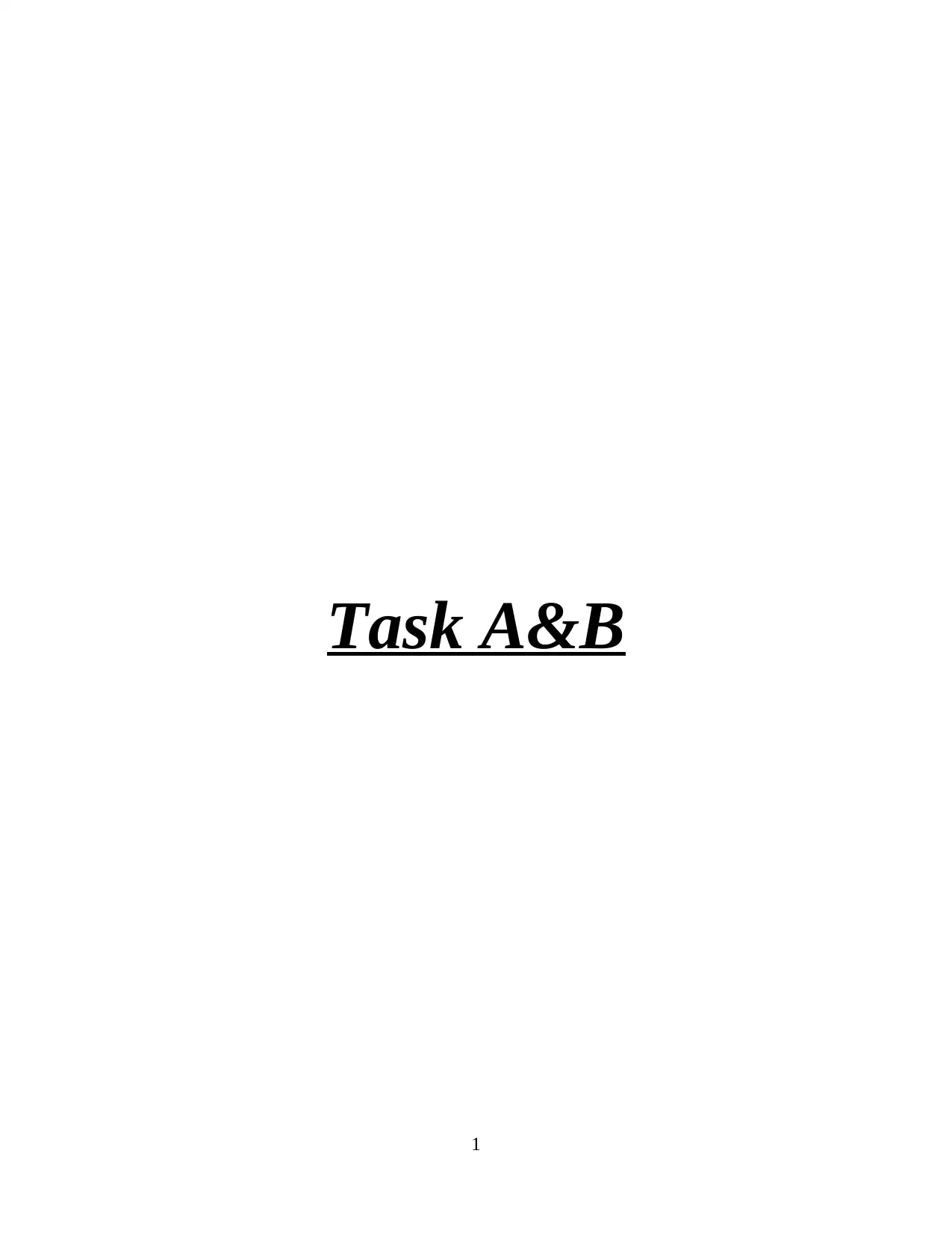
Task A&B
1
1
Paraphrase This Document
Need a fresh take? Get an instant paraphrase of this document with our AI Paraphraser
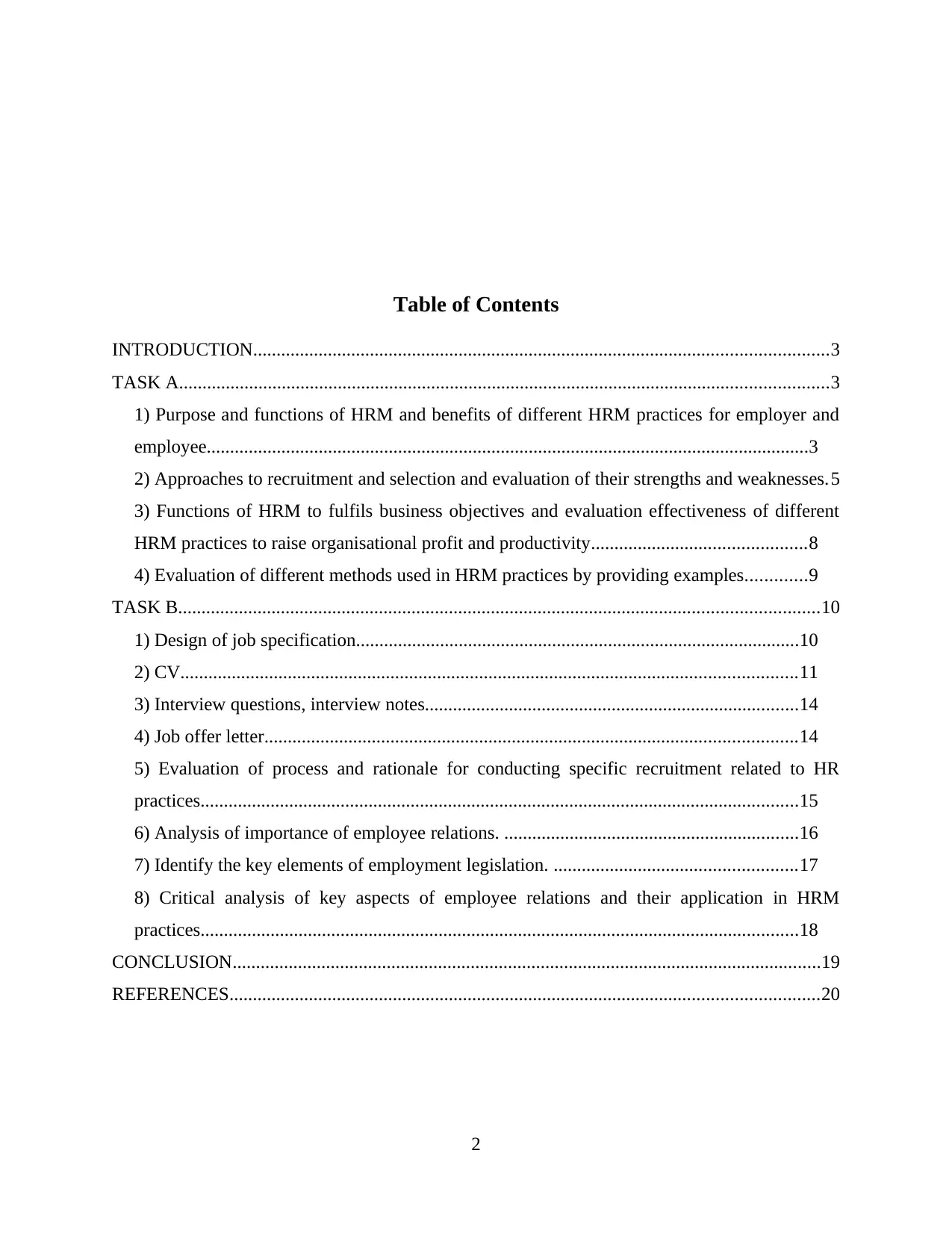
Table of Contents
INTRODUCTION...........................................................................................................................3
TASK A...........................................................................................................................................3
1) Purpose and functions of HRM and benefits of different HRM practices for employer and
employee.................................................................................................................................3
2) Approaches to recruitment and selection and evaluation of their strengths and weaknesses.5
3) Functions of HRM to fulfils business objectives and evaluation effectiveness of different
HRM practices to raise organisational profit and productivity..............................................8
4) Evaluation of different methods used in HRM practices by providing examples.............9
TASK B.........................................................................................................................................10
1) Design of job specification...............................................................................................10
2) CV....................................................................................................................................11
3) Interview questions, interview notes................................................................................14
4) Job offer letter..................................................................................................................14
5) Evaluation of process and rationale for conducting specific recruitment related to HR
practices................................................................................................................................15
6) Analysis of importance of employee relations. ...............................................................16
7) Identify the key elements of employment legislation. ....................................................17
8) Critical analysis of key aspects of employee relations and their application in HRM
practices................................................................................................................................18
CONCLUSION..............................................................................................................................19
REFERENCES..............................................................................................................................20
2
INTRODUCTION...........................................................................................................................3
TASK A...........................................................................................................................................3
1) Purpose and functions of HRM and benefits of different HRM practices for employer and
employee.................................................................................................................................3
2) Approaches to recruitment and selection and evaluation of their strengths and weaknesses.5
3) Functions of HRM to fulfils business objectives and evaluation effectiveness of different
HRM practices to raise organisational profit and productivity..............................................8
4) Evaluation of different methods used in HRM practices by providing examples.............9
TASK B.........................................................................................................................................10
1) Design of job specification...............................................................................................10
2) CV....................................................................................................................................11
3) Interview questions, interview notes................................................................................14
4) Job offer letter..................................................................................................................14
5) Evaluation of process and rationale for conducting specific recruitment related to HR
practices................................................................................................................................15
6) Analysis of importance of employee relations. ...............................................................16
7) Identify the key elements of employment legislation. ....................................................17
8) Critical analysis of key aspects of employee relations and their application in HRM
practices................................................................................................................................18
CONCLUSION..............................................................................................................................19
REFERENCES..............................................................................................................................20
2

INTRODUCTION
Human resource management is defined as strategic approach for proper management of
people in organisation so that competitive advantage can be achieved (Azari, Ozger and Cavdar,
2019). This is designed for maximization of employee performance with relation to business goal
and objectives. It is function of administration with focus on motivating, hiring, maintaining,
training and developing working force of organisation. This is managed by Human Resource
(HR) manager who is liable for providing training to employees, performance appraisal,
recruitment, reward management and so on. Main motto of HR is assisting organisation to
achieve success as well as growth through their people or working force in appropriate manner.
It is very important for organisation to have skilled and knowledge employees so that they can
attain goal and objectives.
The given report is based on Mont Rose College of Management & Science (MRC)
which was established in 2006 at Ilford area of London, United Kingdom. It is higher and further
education college that focus on providing teaching, public service and research in context to
education, development of student and continuing education. Principal of college is Bilal Sheikh
and deputy head is Sayeda Zain. This is the foundation which provide better future as well as
value to students in effective manner. The main aim of report is to discuss about purpose and
scope of HRM in terms of resourcing business with skilled and talent force to attain business
objectives. It also evaluate effectiveness of key elements in context to business. This report
analyse internal as well as external factors which affect HRM decision making including
employment legislation. It also highlights about job specification, CV, interview questions and
offer letter. The process of recruitment is performed along with importance of employee relation
in organisation.
TASK A
1) Purpose and functions of HRM and benefits of different HRM practices for employer and
employee
Human Resource Management (HRM) is defined as practices of hiring, managing,
recruiting and deploying employees of organisation. It is also called as Human Resources (HR)
who is liable for creation, putting and overviewing policies through workers as well as
maintaining relation with them (human resource management (HRM), 2020). It is very important
3
Human resource management is defined as strategic approach for proper management of
people in organisation so that competitive advantage can be achieved (Azari, Ozger and Cavdar,
2019). This is designed for maximization of employee performance with relation to business goal
and objectives. It is function of administration with focus on motivating, hiring, maintaining,
training and developing working force of organisation. This is managed by Human Resource
(HR) manager who is liable for providing training to employees, performance appraisal,
recruitment, reward management and so on. Main motto of HR is assisting organisation to
achieve success as well as growth through their people or working force in appropriate manner.
It is very important for organisation to have skilled and knowledge employees so that they can
attain goal and objectives.
The given report is based on Mont Rose College of Management & Science (MRC)
which was established in 2006 at Ilford area of London, United Kingdom. It is higher and further
education college that focus on providing teaching, public service and research in context to
education, development of student and continuing education. Principal of college is Bilal Sheikh
and deputy head is Sayeda Zain. This is the foundation which provide better future as well as
value to students in effective manner. The main aim of report is to discuss about purpose and
scope of HRM in terms of resourcing business with skilled and talent force to attain business
objectives. It also evaluate effectiveness of key elements in context to business. This report
analyse internal as well as external factors which affect HRM decision making including
employment legislation. It also highlights about job specification, CV, interview questions and
offer letter. The process of recruitment is performed along with importance of employee relation
in organisation.
TASK A
1) Purpose and functions of HRM and benefits of different HRM practices for employer and
employee
Human Resource Management (HRM) is defined as practices of hiring, managing,
recruiting and deploying employees of organisation. It is also called as Human Resources (HR)
who is liable for creation, putting and overviewing policies through workers as well as
maintaining relation with them (human resource management (HRM), 2020). It is very important
3
⊘ This is a preview!⊘
Do you want full access?
Subscribe today to unlock all pages.

Trusted by 1+ million students worldwide
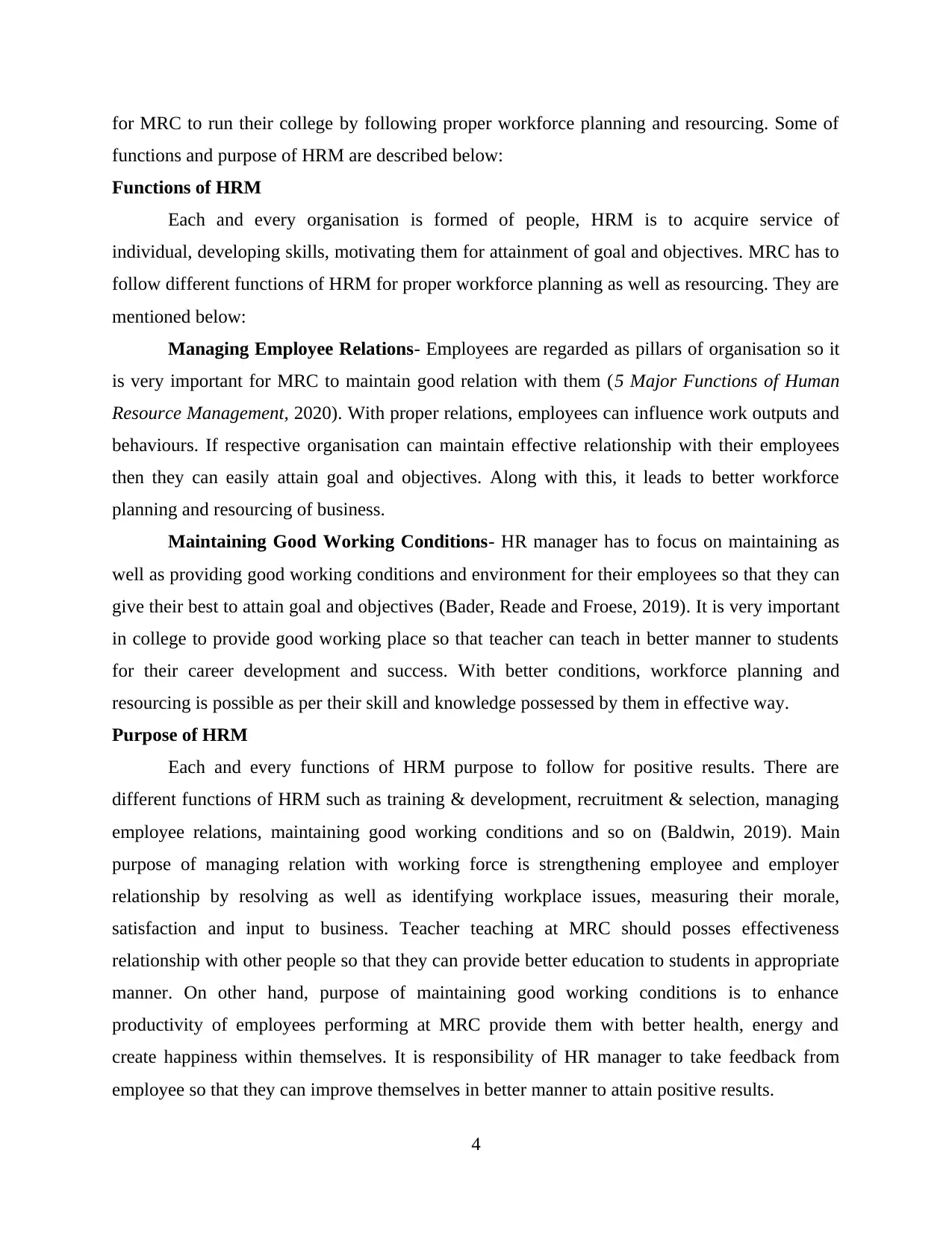
for MRC to run their college by following proper workforce planning and resourcing. Some of
functions and purpose of HRM are described below:
Functions of HRM
Each and every organisation is formed of people, HRM is to acquire service of
individual, developing skills, motivating them for attainment of goal and objectives. MRC has to
follow different functions of HRM for proper workforce planning as well as resourcing. They are
mentioned below:
Managing Employee Relations- Employees are regarded as pillars of organisation so it
is very important for MRC to maintain good relation with them (5 Major Functions of Human
Resource Management, 2020). With proper relations, employees can influence work outputs and
behaviours. If respective organisation can maintain effective relationship with their employees
then they can easily attain goal and objectives. Along with this, it leads to better workforce
planning and resourcing of business.
Maintaining Good Working Conditions- HR manager has to focus on maintaining as
well as providing good working conditions and environment for their employees so that they can
give their best to attain goal and objectives (Bader, Reade and Froese, 2019). It is very important
in college to provide good working place so that teacher can teach in better manner to students
for their career development and success. With better conditions, workforce planning and
resourcing is possible as per their skill and knowledge possessed by them in effective way.
Purpose of HRM
Each and every functions of HRM purpose to follow for positive results. There are
different functions of HRM such as training & development, recruitment & selection, managing
employee relations, maintaining good working conditions and so on (Baldwin, 2019). Main
purpose of managing relation with working force is strengthening employee and employer
relationship by resolving as well as identifying workplace issues, measuring their morale,
satisfaction and input to business. Teacher teaching at MRC should posses effectiveness
relationship with other people so that they can provide better education to students in appropriate
manner. On other hand, purpose of maintaining good working conditions is to enhance
productivity of employees performing at MRC provide them with better health, energy and
create happiness within themselves. It is responsibility of HR manager to take feedback from
employee so that they can improve themselves in better manner to attain positive results.
4
functions and purpose of HRM are described below:
Functions of HRM
Each and every organisation is formed of people, HRM is to acquire service of
individual, developing skills, motivating them for attainment of goal and objectives. MRC has to
follow different functions of HRM for proper workforce planning as well as resourcing. They are
mentioned below:
Managing Employee Relations- Employees are regarded as pillars of organisation so it
is very important for MRC to maintain good relation with them (5 Major Functions of Human
Resource Management, 2020). With proper relations, employees can influence work outputs and
behaviours. If respective organisation can maintain effective relationship with their employees
then they can easily attain goal and objectives. Along with this, it leads to better workforce
planning and resourcing of business.
Maintaining Good Working Conditions- HR manager has to focus on maintaining as
well as providing good working conditions and environment for their employees so that they can
give their best to attain goal and objectives (Bader, Reade and Froese, 2019). It is very important
in college to provide good working place so that teacher can teach in better manner to students
for their career development and success. With better conditions, workforce planning and
resourcing is possible as per their skill and knowledge possessed by them in effective way.
Purpose of HRM
Each and every functions of HRM purpose to follow for positive results. There are
different functions of HRM such as training & development, recruitment & selection, managing
employee relations, maintaining good working conditions and so on (Baldwin, 2019). Main
purpose of managing relation with working force is strengthening employee and employer
relationship by resolving as well as identifying workplace issues, measuring their morale,
satisfaction and input to business. Teacher teaching at MRC should posses effectiveness
relationship with other people so that they can provide better education to students in appropriate
manner. On other hand, purpose of maintaining good working conditions is to enhance
productivity of employees performing at MRC provide them with better health, energy and
create happiness within themselves. It is responsibility of HR manager to take feedback from
employee so that they can improve themselves in better manner to attain positive results.
4
Paraphrase This Document
Need a fresh take? Get an instant paraphrase of this document with our AI Paraphraser

Benefits of Different HRM Practices
HRM practices are those activity which assist manager as well as employees to improve
effectiveness of business. It consists of setting expectations of work, monitoring performance of
working force, assisting performance of employees, appraising and rewarding for good
performance. The different HRM practices includes providing security to working force, training
in relevant skills, fair compensation based on performance, skill monitoring & training and many
more (Functions & Practices of Human Resource Management, 2020). These provide benefits to
employer and employees of MRC.
Benefits to Employer
Security to Working Force- This practice of HRM provide benefits to MRC employer
in terms of enhancement of brand value and goodwill. It also assist employer to give their best
efforts in order to attain goal and objectives in effective and efficient manner.
Training in Relevant Skills- It is very important for MRC to conduct training on regular
basis for their employer to know about requirement of their students and apply those in their own
college (Bos-Nehles and Veenendaal, 2019). Employer includes manager, CEO, principal all
should update themselves to enhance their skills and knowledge regarding particular field.
Benefits to Employee
Fair Compensation- As each and every employees perform work for money so they
should be provide fair compensation based on their performance. If MRC follow such practice in
their college then their employees work in better manner to provide education to students and
creates loyalty and trust towards their working place.
Skill Monitoring & Training- It is the important practices which should be followed by
MRC. The working employee skills should be monitored on regular basis and provide training if
they lack in any areas. This provide benefit to employee for better work performance.
2) Approaches to recruitment and selection and evaluation of their strengths and weaknesses
Recruitment
It is defined as procedure to hire as well as find most suitable and qualified candidates for
given job opening or vacancy in cost and time effective mode (Campanella and et. al., 2020).
This is method of searching for potential employees and encouraging them for applying to given
jobs in enterprise. It is regarded as process that start with identifying need of business in relation
to job vacancy and finish with introducing new employee to business.
5
HRM practices are those activity which assist manager as well as employees to improve
effectiveness of business. It consists of setting expectations of work, monitoring performance of
working force, assisting performance of employees, appraising and rewarding for good
performance. The different HRM practices includes providing security to working force, training
in relevant skills, fair compensation based on performance, skill monitoring & training and many
more (Functions & Practices of Human Resource Management, 2020). These provide benefits to
employer and employees of MRC.
Benefits to Employer
Security to Working Force- This practice of HRM provide benefits to MRC employer
in terms of enhancement of brand value and goodwill. It also assist employer to give their best
efforts in order to attain goal and objectives in effective and efficient manner.
Training in Relevant Skills- It is very important for MRC to conduct training on regular
basis for their employer to know about requirement of their students and apply those in their own
college (Bos-Nehles and Veenendaal, 2019). Employer includes manager, CEO, principal all
should update themselves to enhance their skills and knowledge regarding particular field.
Benefits to Employee
Fair Compensation- As each and every employees perform work for money so they
should be provide fair compensation based on their performance. If MRC follow such practice in
their college then their employees work in better manner to provide education to students and
creates loyalty and trust towards their working place.
Skill Monitoring & Training- It is the important practices which should be followed by
MRC. The working employee skills should be monitored on regular basis and provide training if
they lack in any areas. This provide benefit to employee for better work performance.
2) Approaches to recruitment and selection and evaluation of their strengths and weaknesses
Recruitment
It is defined as procedure to hire as well as find most suitable and qualified candidates for
given job opening or vacancy in cost and time effective mode (Campanella and et. al., 2020).
This is method of searching for potential employees and encouraging them for applying to given
jobs in enterprise. It is regarded as process that start with identifying need of business in relation
to job vacancy and finish with introducing new employee to business.
5

Approaches to Recruitment
The approaches to recruitment are described below:
Internal Recruitment- It is defined as source of recruitment that motivate employees of
enterprise in order to apply for opening vacancy within business place. Here, job opening are
informed through word of mouth, internal advertisement within organisation. It is used by
business to create motivation among skilled employees, reducing turnover, cost reduction to
achieve competitive advantages. This can be used by MRC for hiring skilled and capable
employees within same workplace for positive outcomes. It includes transfer, employee referrals,
promotion, demotion, retired employees (Internal and External Sources of Recruitment, 2016).
These all are performed within same workplace to hire capable and known person to
organisation. This approach has some strengths and weaknesses such as:
Strengths Weaknesses
When internal employees are provided
higher post then their morale rise for
better work performance.
Internal recruitment leads to promote
employees as they feel happy as well as
secure for opportunity of advancement.
This discourage people who are from
outside for joining business.
There is high chances of rising conflicts
among candidates because many
undeserving employees get chance for
promotion.
External Recruitment- It is defined as external source of recruitment which focus on
motivating potential as well as skilled candidates to business in order to apply for job opening in
effective manner (Cooke and et. al., 2019). The vacancy are informed through external source
such as media advertisement, factory gate recruitment, campus placement, walk-ins interview,
management consultants, employment exchange, casual callers, recruiting, deputation,
professional association. This can be used by MRC for hiring new post of receptionist for their
college in appropriate way. Such method can help them to hire capable and skilled employees for
work performance. It carry both strengths and weaknesses such as:
Strengths Weaknesses
It creates opportunity to select best and
suitable candidates from pool.
It is time consuming as well as
expensive method along with there is
6
The approaches to recruitment are described below:
Internal Recruitment- It is defined as source of recruitment that motivate employees of
enterprise in order to apply for opening vacancy within business place. Here, job opening are
informed through word of mouth, internal advertisement within organisation. It is used by
business to create motivation among skilled employees, reducing turnover, cost reduction to
achieve competitive advantages. This can be used by MRC for hiring skilled and capable
employees within same workplace for positive outcomes. It includes transfer, employee referrals,
promotion, demotion, retired employees (Internal and External Sources of Recruitment, 2016).
These all are performed within same workplace to hire capable and known person to
organisation. This approach has some strengths and weaknesses such as:
Strengths Weaknesses
When internal employees are provided
higher post then their morale rise for
better work performance.
Internal recruitment leads to promote
employees as they feel happy as well as
secure for opportunity of advancement.
This discourage people who are from
outside for joining business.
There is high chances of rising conflicts
among candidates because many
undeserving employees get chance for
promotion.
External Recruitment- It is defined as external source of recruitment which focus on
motivating potential as well as skilled candidates to business in order to apply for job opening in
effective manner (Cooke and et. al., 2019). The vacancy are informed through external source
such as media advertisement, factory gate recruitment, campus placement, walk-ins interview,
management consultants, employment exchange, casual callers, recruiting, deputation,
professional association. This can be used by MRC for hiring new post of receptionist for their
college in appropriate way. Such method can help them to hire capable and skilled employees for
work performance. It carry both strengths and weaknesses such as:
Strengths Weaknesses
It creates opportunity to select best and
suitable candidates from pool.
It is time consuming as well as
expensive method along with there is
6
⊘ This is a preview!⊘
Do you want full access?
Subscribe today to unlock all pages.

Trusted by 1+ million students worldwide

The external source bring new ideas
which provide benefits to organisation.
no guarantee to get suitable candidates.
There is problem in cooperation as old
staff does not cooperate with new one.
Selection
It is defined as procedure to chose potential and suitable candidate for vacant position in
business (Fletcher, 2019). This means taking out unsuitable applicants and selecting best one
who possess capabilities and qualification in order to fill vacant position arise in organisation.
The respective organisation has to select appropriate candidate for their opening so that they can
attain goal and objectives.
Approaches to Selection
There are different approaches to selection such as application forms and Cvs, online
screening & short-listing, interview, psychometric testing, aptitude tests, personality profiling
and many more. They are described below:
Interview- It is defined as structured conversation in which participants are asked
different questions by interviewer and they are liable to answered them. This is face to face
interaction among interviewee and interviewer. It is very easy approach of selection method to
select suitable candidates. The strengths and weaknesses are described below:
Strengths Weaknesses
It helps in building relationship
between interview and interviewer.
This assist in selecting suitable
candidate because it leads to know
interviewer more about person
(Advantage and disadvantage of
interview, 2019).
It is not possible to select candidate
through interview only.
There is no record of interview process
as there is no evidence for future time
period.
Aptitude Test- It is defined as exam or test which is conducted by organisation for their
candidates in order to determine their skills and interests regarding particular field (Grech,
Horberry and Koester, 2019). It is important for business to conduct test for knowing candidate
7
which provide benefits to organisation.
no guarantee to get suitable candidates.
There is problem in cooperation as old
staff does not cooperate with new one.
Selection
It is defined as procedure to chose potential and suitable candidate for vacant position in
business (Fletcher, 2019). This means taking out unsuitable applicants and selecting best one
who possess capabilities and qualification in order to fill vacant position arise in organisation.
The respective organisation has to select appropriate candidate for their opening so that they can
attain goal and objectives.
Approaches to Selection
There are different approaches to selection such as application forms and Cvs, online
screening & short-listing, interview, psychometric testing, aptitude tests, personality profiling
and many more. They are described below:
Interview- It is defined as structured conversation in which participants are asked
different questions by interviewer and they are liable to answered them. This is face to face
interaction among interviewee and interviewer. It is very easy approach of selection method to
select suitable candidates. The strengths and weaknesses are described below:
Strengths Weaknesses
It helps in building relationship
between interview and interviewer.
This assist in selecting suitable
candidate because it leads to know
interviewer more about person
(Advantage and disadvantage of
interview, 2019).
It is not possible to select candidate
through interview only.
There is no record of interview process
as there is no evidence for future time
period.
Aptitude Test- It is defined as exam or test which is conducted by organisation for their
candidates in order to determine their skills and interests regarding particular field (Grech,
Horberry and Koester, 2019). It is important for business to conduct test for knowing candidate
7
Paraphrase This Document
Need a fresh take? Get an instant paraphrase of this document with our AI Paraphraser
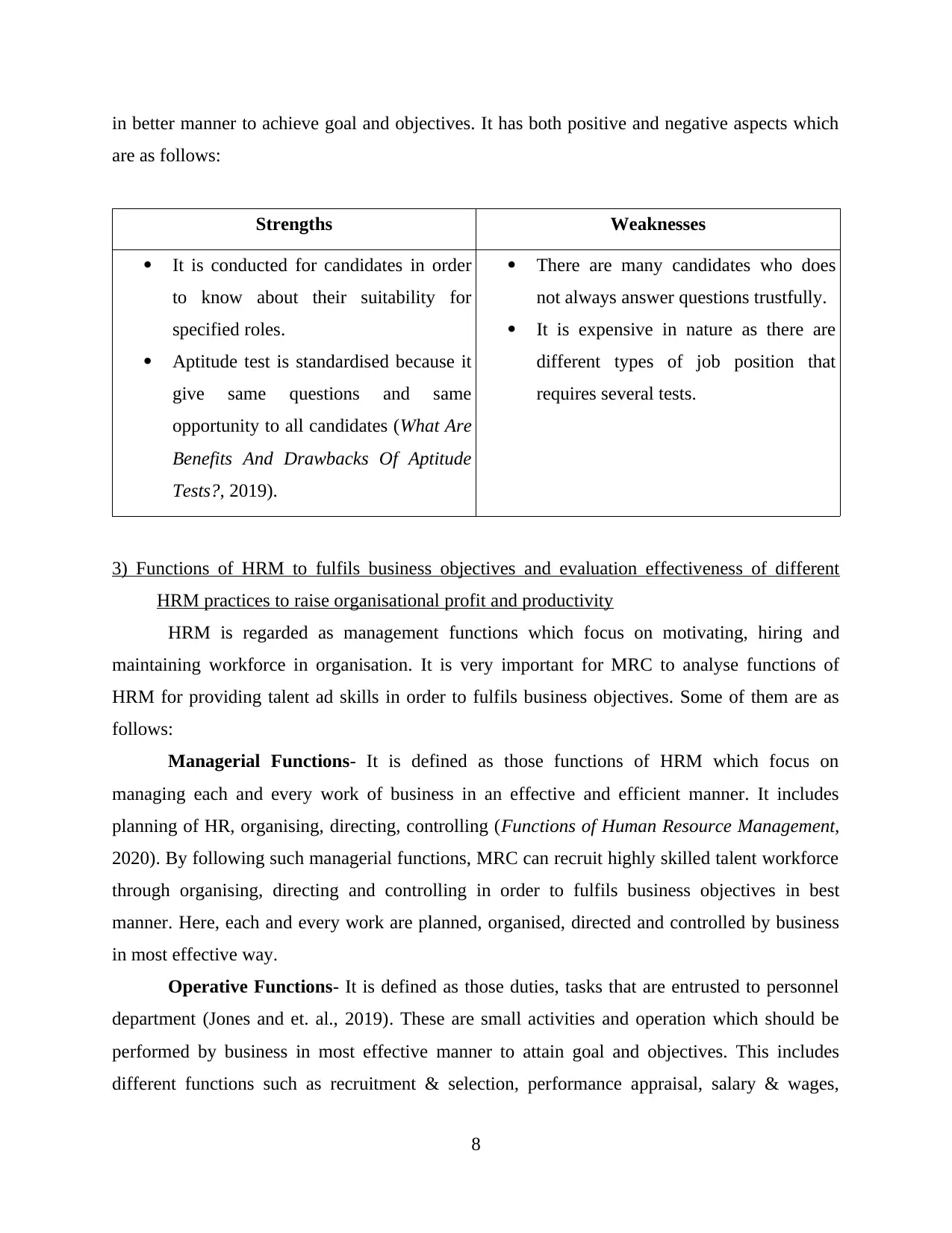
in better manner to achieve goal and objectives. It has both positive and negative aspects which
are as follows:
Strengths Weaknesses
It is conducted for candidates in order
to know about their suitability for
specified roles.
Aptitude test is standardised because it
give same questions and same
opportunity to all candidates (What Are
Benefits And Drawbacks Of Aptitude
Tests?, 2019).
There are many candidates who does
not always answer questions trustfully.
It is expensive in nature as there are
different types of job position that
requires several tests.
3) Functions of HRM to fulfils business objectives and evaluation effectiveness of different
HRM practices to raise organisational profit and productivity
HRM is regarded as management functions which focus on motivating, hiring and
maintaining workforce in organisation. It is very important for MRC to analyse functions of
HRM for providing talent ad skills in order to fulfils business objectives. Some of them are as
follows:
Managerial Functions- It is defined as those functions of HRM which focus on
managing each and every work of business in an effective and efficient manner. It includes
planning of HR, organising, directing, controlling (Functions of Human Resource Management,
2020). By following such managerial functions, MRC can recruit highly skilled talent workforce
through organising, directing and controlling in order to fulfils business objectives in best
manner. Here, each and every work are planned, organised, directed and controlled by business
in most effective way.
Operative Functions- It is defined as those duties, tasks that are entrusted to personnel
department (Jones and et. al., 2019). These are small activities and operation which should be
performed by business in most effective manner to attain goal and objectives. This includes
different functions such as recruitment & selection, performance appraisal, salary & wages,
8
are as follows:
Strengths Weaknesses
It is conducted for candidates in order
to know about their suitability for
specified roles.
Aptitude test is standardised because it
give same questions and same
opportunity to all candidates (What Are
Benefits And Drawbacks Of Aptitude
Tests?, 2019).
There are many candidates who does
not always answer questions trustfully.
It is expensive in nature as there are
different types of job position that
requires several tests.
3) Functions of HRM to fulfils business objectives and evaluation effectiveness of different
HRM practices to raise organisational profit and productivity
HRM is regarded as management functions which focus on motivating, hiring and
maintaining workforce in organisation. It is very important for MRC to analyse functions of
HRM for providing talent ad skills in order to fulfils business objectives. Some of them are as
follows:
Managerial Functions- It is defined as those functions of HRM which focus on
managing each and every work of business in an effective and efficient manner. It includes
planning of HR, organising, directing, controlling (Functions of Human Resource Management,
2020). By following such managerial functions, MRC can recruit highly skilled talent workforce
through organising, directing and controlling in order to fulfils business objectives in best
manner. Here, each and every work are planned, organised, directed and controlled by business
in most effective way.
Operative Functions- It is defined as those duties, tasks that are entrusted to personnel
department (Jones and et. al., 2019). These are small activities and operation which should be
performed by business in most effective manner to attain goal and objectives. This includes
different functions such as recruitment & selection, performance appraisal, salary & wages,
8
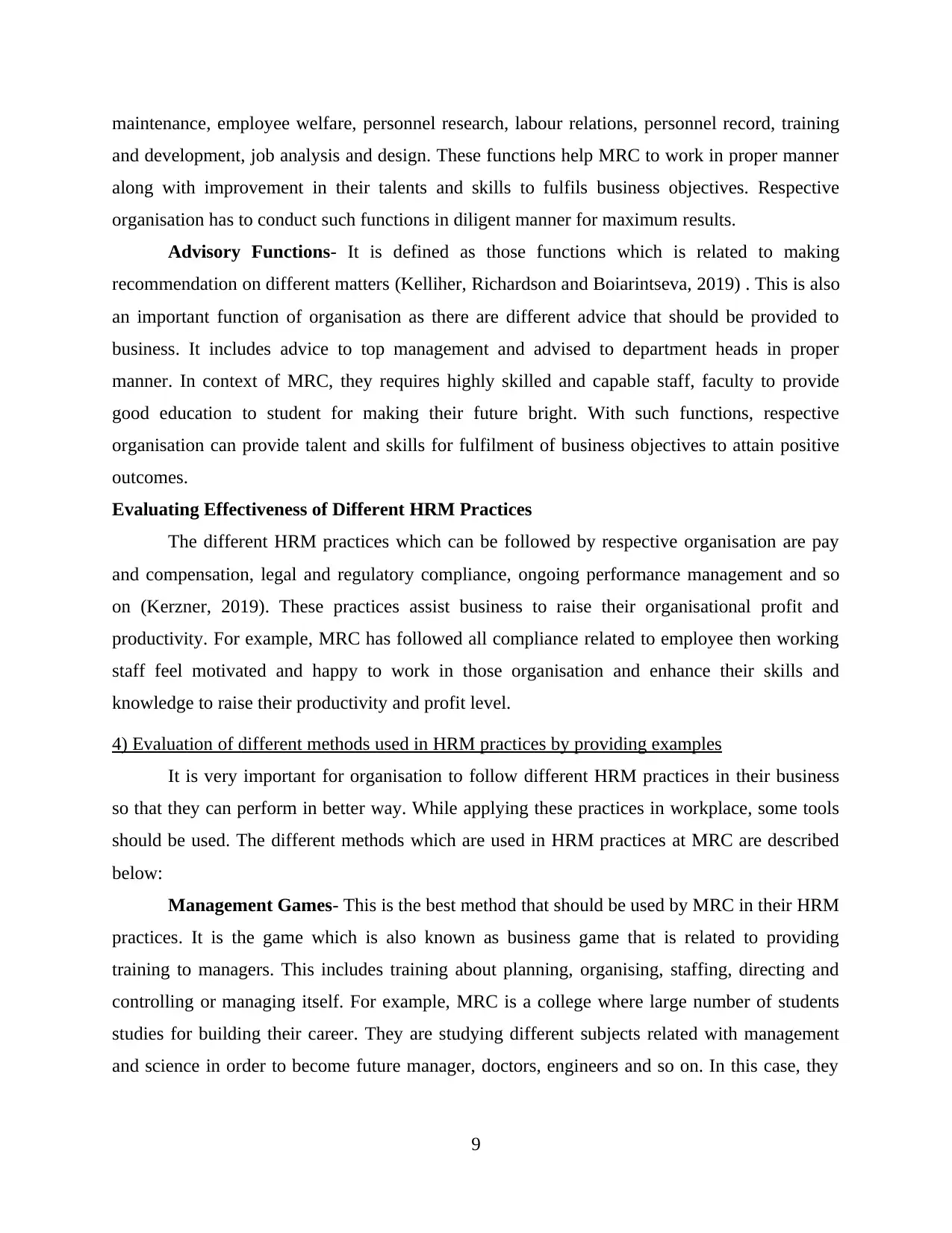
maintenance, employee welfare, personnel research, labour relations, personnel record, training
and development, job analysis and design. These functions help MRC to work in proper manner
along with improvement in their talents and skills to fulfils business objectives. Respective
organisation has to conduct such functions in diligent manner for maximum results.
Advisory Functions- It is defined as those functions which is related to making
recommendation on different matters (Kelliher, Richardson and Boiarintseva, 2019) . This is also
an important function of organisation as there are different advice that should be provided to
business. It includes advice to top management and advised to department heads in proper
manner. In context of MRC, they requires highly skilled and capable staff, faculty to provide
good education to student for making their future bright. With such functions, respective
organisation can provide talent and skills for fulfilment of business objectives to attain positive
outcomes.
Evaluating Effectiveness of Different HRM Practices
The different HRM practices which can be followed by respective organisation are pay
and compensation, legal and regulatory compliance, ongoing performance management and so
on (Kerzner, 2019). These practices assist business to raise their organisational profit and
productivity. For example, MRC has followed all compliance related to employee then working
staff feel motivated and happy to work in those organisation and enhance their skills and
knowledge to raise their productivity and profit level.
4) Evaluation of different methods used in HRM practices by providing examples
It is very important for organisation to follow different HRM practices in their business
so that they can perform in better way. While applying these practices in workplace, some tools
should be used. The different methods which are used in HRM practices at MRC are described
below:
Management Games- This is the best method that should be used by MRC in their HRM
practices. It is the game which is also known as business game that is related to providing
training to managers. This includes training about planning, organising, staffing, directing and
controlling or managing itself. For example, MRC is a college where large number of students
studies for building their career. They are studying different subjects related with management
and science in order to become future manager, doctors, engineers and so on. In this case, they
9
and development, job analysis and design. These functions help MRC to work in proper manner
along with improvement in their talents and skills to fulfils business objectives. Respective
organisation has to conduct such functions in diligent manner for maximum results.
Advisory Functions- It is defined as those functions which is related to making
recommendation on different matters (Kelliher, Richardson and Boiarintseva, 2019) . This is also
an important function of organisation as there are different advice that should be provided to
business. It includes advice to top management and advised to department heads in proper
manner. In context of MRC, they requires highly skilled and capable staff, faculty to provide
good education to student for making their future bright. With such functions, respective
organisation can provide talent and skills for fulfilment of business objectives to attain positive
outcomes.
Evaluating Effectiveness of Different HRM Practices
The different HRM practices which can be followed by respective organisation are pay
and compensation, legal and regulatory compliance, ongoing performance management and so
on (Kerzner, 2019). These practices assist business to raise their organisational profit and
productivity. For example, MRC has followed all compliance related to employee then working
staff feel motivated and happy to work in those organisation and enhance their skills and
knowledge to raise their productivity and profit level.
4) Evaluation of different methods used in HRM practices by providing examples
It is very important for organisation to follow different HRM practices in their business
so that they can perform in better way. While applying these practices in workplace, some tools
should be used. The different methods which are used in HRM practices at MRC are described
below:
Management Games- This is the best method that should be used by MRC in their HRM
practices. It is the game which is also known as business game that is related to providing
training to managers. This includes training about planning, organising, staffing, directing and
controlling or managing itself. For example, MRC is a college where large number of students
studies for building their career. They are studying different subjects related with management
and science in order to become future manager, doctors, engineers and so on. In this case, they
9
⊘ This is a preview!⊘
Do you want full access?
Subscribe today to unlock all pages.

Trusted by 1+ million students worldwide
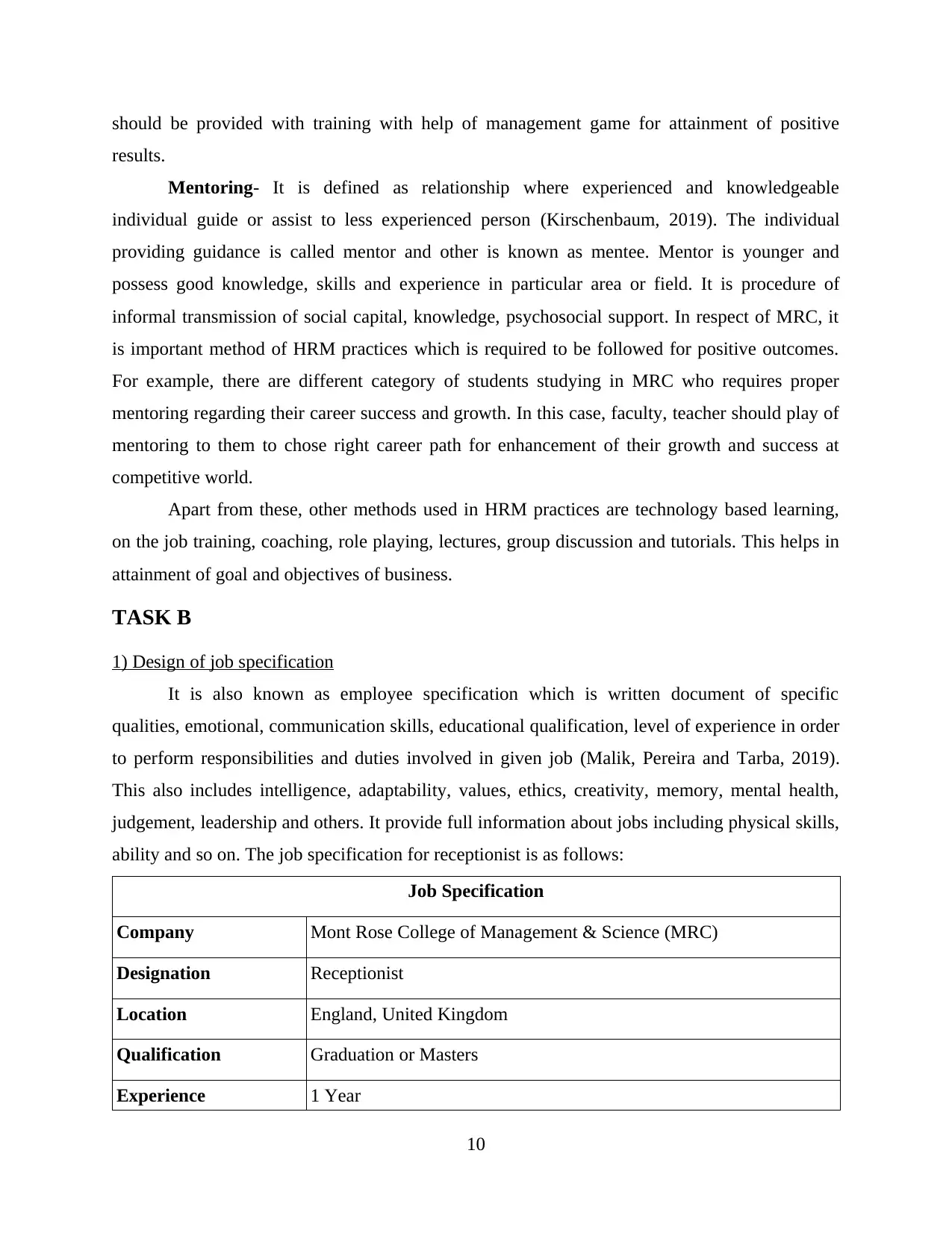
should be provided with training with help of management game for attainment of positive
results.
Mentoring- It is defined as relationship where experienced and knowledgeable
individual guide or assist to less experienced person (Kirschenbaum, 2019). The individual
providing guidance is called mentor and other is known as mentee. Mentor is younger and
possess good knowledge, skills and experience in particular area or field. It is procedure of
informal transmission of social capital, knowledge, psychosocial support. In respect of MRC, it
is important method of HRM practices which is required to be followed for positive outcomes.
For example, there are different category of students studying in MRC who requires proper
mentoring regarding their career success and growth. In this case, faculty, teacher should play of
mentoring to them to chose right career path for enhancement of their growth and success at
competitive world.
Apart from these, other methods used in HRM practices are technology based learning,
on the job training, coaching, role playing, lectures, group discussion and tutorials. This helps in
attainment of goal and objectives of business.
TASK B
1) Design of job specification
It is also known as employee specification which is written document of specific
qualities, emotional, communication skills, educational qualification, level of experience in order
to perform responsibilities and duties involved in given job (Malik, Pereira and Tarba, 2019).
This also includes intelligence, adaptability, values, ethics, creativity, memory, mental health,
judgement, leadership and others. It provide full information about jobs including physical skills,
ability and so on. The job specification for receptionist is as follows:
Job Specification
Company Mont Rose College of Management & Science (MRC)
Designation Receptionist
Location England, United Kingdom
Qualification Graduation or Masters
Experience 1 Year
10
results.
Mentoring- It is defined as relationship where experienced and knowledgeable
individual guide or assist to less experienced person (Kirschenbaum, 2019). The individual
providing guidance is called mentor and other is known as mentee. Mentor is younger and
possess good knowledge, skills and experience in particular area or field. It is procedure of
informal transmission of social capital, knowledge, psychosocial support. In respect of MRC, it
is important method of HRM practices which is required to be followed for positive outcomes.
For example, there are different category of students studying in MRC who requires proper
mentoring regarding their career success and growth. In this case, faculty, teacher should play of
mentoring to them to chose right career path for enhancement of their growth and success at
competitive world.
Apart from these, other methods used in HRM practices are technology based learning,
on the job training, coaching, role playing, lectures, group discussion and tutorials. This helps in
attainment of goal and objectives of business.
TASK B
1) Design of job specification
It is also known as employee specification which is written document of specific
qualities, emotional, communication skills, educational qualification, level of experience in order
to perform responsibilities and duties involved in given job (Malik, Pereira and Tarba, 2019).
This also includes intelligence, adaptability, values, ethics, creativity, memory, mental health,
judgement, leadership and others. It provide full information about jobs including physical skills,
ability and so on. The job specification for receptionist is as follows:
Job Specification
Company Mont Rose College of Management & Science (MRC)
Designation Receptionist
Location England, United Kingdom
Qualification Graduation or Masters
Experience 1 Year
10
Paraphrase This Document
Need a fresh take? Get an instant paraphrase of this document with our AI Paraphraser

Skills Communication
Organisation
Interpersonal skills
Problem Solving skills
Multitasking
Critical Thinking
Presentable
Responsibilities Attending phone calls
Greeting each and every visitors
Providing information to all students and parents
Talking in polite manner
Working as per plans and policies
Handling front desk work
Maintaining security as well as telecommunications system
2) CV
It is defined as written document of someone's life work which includes publications,
formation, qualification and so on (Mattingly and Kraiger, 2019) . This is presented by
candidates while looking for job in an organisation. CV is prepared by experienced person who
includes all their qualification, objectives and so on. CV is prepared for teaching assistant of
primary school which is as given below:
11
Organisation
Interpersonal skills
Problem Solving skills
Multitasking
Critical Thinking
Presentable
Responsibilities Attending phone calls
Greeting each and every visitors
Providing information to all students and parents
Talking in polite manner
Working as per plans and policies
Handling front desk work
Maintaining security as well as telecommunications system
2) CV
It is defined as written document of someone's life work which includes publications,
formation, qualification and so on (Mattingly and Kraiger, 2019) . This is presented by
candidates while looking for job in an organisation. CV is prepared by experienced person who
includes all their qualification, objectives and so on. CV is prepared for teaching assistant of
primary school which is as given below:
11
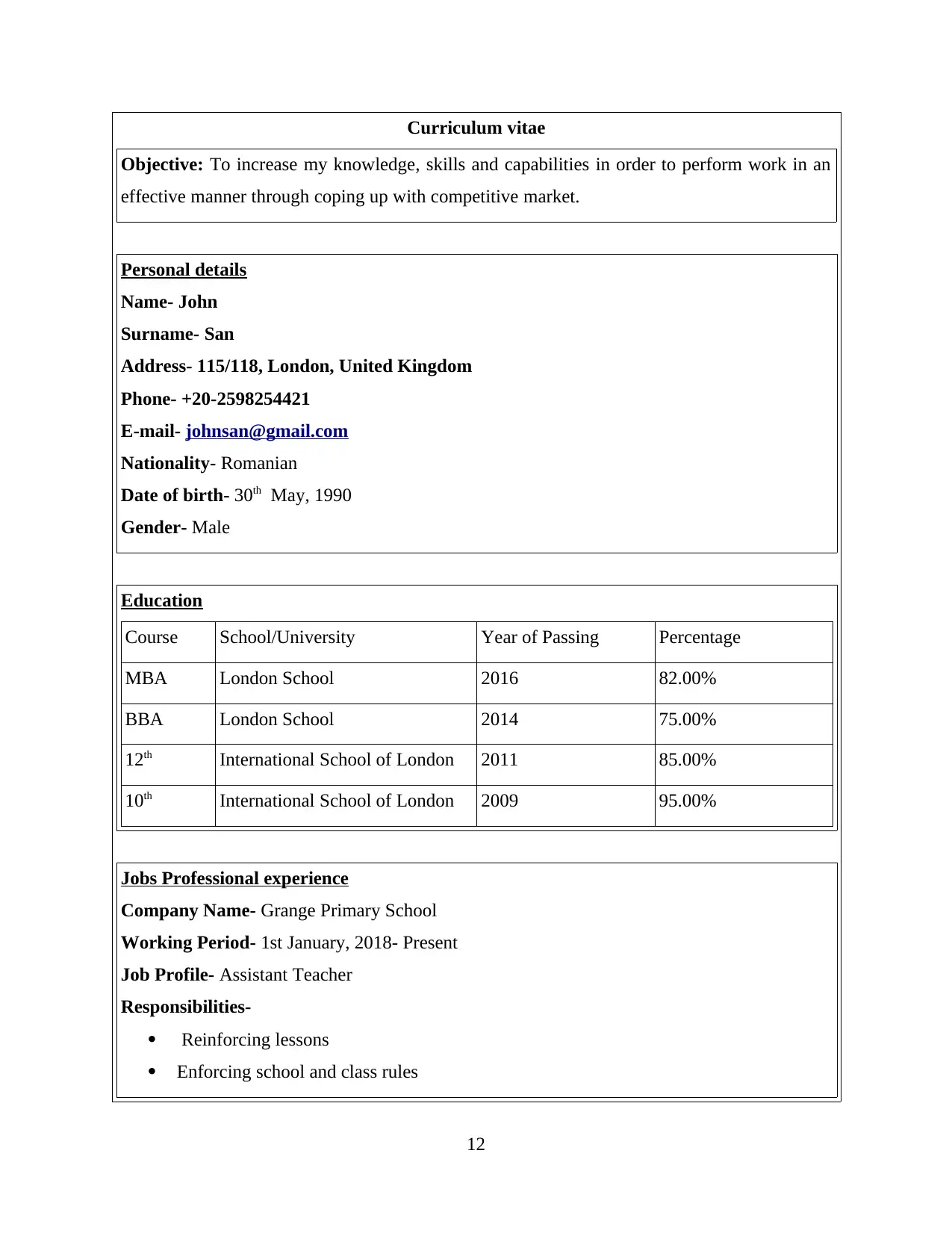
Curriculum vitae
Objective: To increase my knowledge, skills and capabilities in order to perform work in an
effective manner through coping up with competitive market.
Personal details
Name- John
Surname- San
Address- 115/118, London, United Kingdom
Phone- +20-2598254421
E-mail- johnsan@gmail.com
Nationality- Romanian
Date of birth- 30th May, 1990
Gender- Male
Education
Course School/University Year of Passing Percentage
MBA London School 2016 82.00%
BBA London School 2014 75.00%
12th International School of London 2011 85.00%
10th International School of London 2009 95.00%
Jobs Professional experience
Company Name- Grange Primary School
Working Period- 1st January, 2018- Present
Job Profile- Assistant Teacher
Responsibilities-
Reinforcing lessons
Enforcing school and class rules
12
Objective: To increase my knowledge, skills and capabilities in order to perform work in an
effective manner through coping up with competitive market.
Personal details
Name- John
Surname- San
Address- 115/118, London, United Kingdom
Phone- +20-2598254421
E-mail- johnsan@gmail.com
Nationality- Romanian
Date of birth- 30th May, 1990
Gender- Male
Education
Course School/University Year of Passing Percentage
MBA London School 2016 82.00%
BBA London School 2014 75.00%
12th International School of London 2011 85.00%
10th International School of London 2009 95.00%
Jobs Professional experience
Company Name- Grange Primary School
Working Period- 1st January, 2018- Present
Job Profile- Assistant Teacher
Responsibilities-
Reinforcing lessons
Enforcing school and class rules
12
⊘ This is a preview!⊘
Do you want full access?
Subscribe today to unlock all pages.

Trusted by 1+ million students worldwide
1 out of 23
Related Documents
Your All-in-One AI-Powered Toolkit for Academic Success.
+13062052269
info@desklib.com
Available 24*7 on WhatsApp / Email
![[object Object]](/_next/static/media/star-bottom.7253800d.svg)
Unlock your academic potential
Copyright © 2020–2025 A2Z Services. All Rights Reserved. Developed and managed by ZUCOL.




